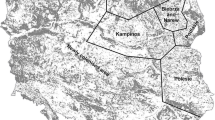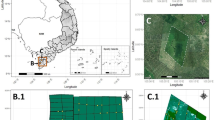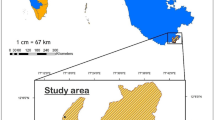Abstract
Camera trapping is the most used method for surveying medium-sized carnivores in Spain. The main target for these surveys has been the Iberian lynx, the most endangered cat in the world. The Iberian lynx conservation program has received the largest EU LIFE projects grant. So, efficiency is a key goal for managing this grant. During 2003 and 2007, we have applied these funds to the survey of the Iberian lynx in Eastern Sierra Morena (Spain). Using two different techniques, we have studied both to see which is the most efficient. The survey developed in active latrines resulted more efficient than that of scent stations and live prey camera trapping throughout the years, although there has been a variation between years. Otherwise, the live prey method has been the one providing the greatest speed and number of pictures per entrance. We suggest that camera-trapping surveys can be improved in terms of efficiency for a wide range of species, or at least for the Iberian lynx. To improve the results, cameras might be placed in relation to breeding territories. With this determinant, camera-trapping surveys would be shorter than 120 days. Finally, we suggest how those surveys for medium carnivores should be designed.



Similar content being viewed by others
References
Beltran JF (1991) Temporal abundance pattern of the wild rabbit in Doñana, SW Spain. Mammalia 55:591–599
Beltran JF, Delibes M (1994) Environmental determinants of circadian activity of free-ranging Iberian lynxes. J Mammal 75(2):382–393
Carbone C, Christie S, Conforti K, Coulson T, Franklin N, Ginsberg JR, Griffith M, Holden J, Kawanishi K, Kinnaird M, Laidlaw R, Lynam A, Macdonald DW, Martyr D, McDougal C, Nath L, O’Brien T, Seidensticker J, Smith DJL, Sunquist ME, Tilson R (2001) The use of photographic rates to estimate densities of tigers and other cryptic mammals. Anim Conserv 4:75–79
Cutler TL, Swann DE (1999) Using remote photography in wildlife ecology: a review. Wildl Soc Bul 27(3):571–581
Delibes M (1980) Feeding ecology of the Spanish lynx in the Coto Donana. Acta Thériol 25(24):309–324
Fernandez N, Palomares F, Delibes M (2002) The use of breeding dens and kitten development in the Iberian lynx (Lynx pardinus). J Zool 258:1–5
Ferreras P, Delibes M, Palomares F, Fedriani JM, Calzada J, Revilla E (2004) Proximate and ultimate causes of dispersal in the Iberian lynx Lynx pardinus. Behav Ecol 15(1):31–40
Fundación CBD-Habitat (2006) Informe final de actividades del proyecto Life02/NAT/E/8609 Recuperación de las poblaciones de lince ibérico en Andalucía. Report to the European Commission, Madrid, Spain
García-Perea R (1996) Patterns of postnatal development in skull of lynxes, Genus Lynx (Mammalia: Carnivora). J Morphol 229:241–254
Gil-Sánchez JM (2006) Recuperación de las poblaciones de lince ibérico en Andalucía: memoria de resultados 2002–2006 en Sierra Morena. Report to the European Commission on Life Project 02/NAT/E/8609. Environment Ministry, Andalusia Government. Seville, Spain
Gonzalez LM, San Miguel A (2005) Manual de gestión de fincas de monte mediterráneo en la Red Natura 2000. Ministerio de Medio Ambiente, Madrid
Griffiths M, Van Schaick M (1993) Camera-trapping: a new tool for the study of elusive rain forest animals. Trop Biodiversity 1:131–135
Guzman JN, García FJ, Garrote G, Perez de Ayala R, Iglesias C (2004) El lince iberico (Lynx pardinus) en España y Portugal. Censo-diagnóstico de sus poblaciones. Ministerio de Medio Ambiente, Madrid
Haines AM, Janecka JE, Tewes ME, Grassman LI, Morton P (2006) The importance of private lands for ocelot Leopardus pardalis conservation in the United States. Oryx 40:90–94
Hayes RA, Nahrung HF, Wilson JC (2006) The response of native Australian rodents to predator odours varies seasonally: a by-product of life history variation? Anim Behav 71(6):1307–1314
Heilbrun RD, Silvy NJ, Tewes ME, Peterson MJ (2003) Using automatically triggered cameras to individually identify bobcats. Wildl Soc Bul 31(3):748–755
Jackson RM, Roe JD, Wangchuk R, Hunter DO (2005) Surveying snow leopard populations with emphasis on camera trapping: a handbook. The Snow Leopard Conservancy, Sonoma
Johnson WE, O’Brien SJ (1997) Phylogenetic reconstruction of the Felidae using 16S rRNA and NADH-5 mitochondrial genes. J Mol Evol 44(suppl 1):98–116
Kelly MJ, Holub EL (2008) Camera trapping of carnivores: trap success among camera types and across species, and habitat selection by species, on Salt Pond Mountain, Giles County, Virginia. Northeast Nat 15(2):249–262
Kery M, Schmidt H (2004) Monitoring programs need to take into account imperfect species detectability. Basic Appl Ecol 5(1):65–73
Lombardi L, Fernandez N, Moreno S, Villafuerte R (2003) Habitat related difference in rabbit (Oryctolagus cuniculus) abundance, distribution and activity. J Mamm 84(1):26–36
Lombardi L, Fernandez N, Moreno S (2007) Habitat use and spatial behaviour in the European rabbit in three Mediterranean environments. Basic Appl Ecol 8:453–463
MMA (2002) Valores normales y estadísticos de observatorios meteorológicos principales (1971–2000) Volumen 5. Andalucía y Melilla. Ministerio de Medio Ambiente, Madrid
MMA (2004) Programa de Funcionamiento. Centro de Cría del Lince Ibérico El Acebuche, Parque Nacional de Doñana
Muñoz-Igualada J, Shivik JA, Dominguez FG, Lara J, Gonzalez LM (2008) Evaluation of cage-traps and cable restraint devices to capture red foxes in Spain. J Wildl Manag 72(3):830–836
Nowell K (2002) Revision of the Felidae Red List of threatened species. Cat News 37:4–7
Palomares F (2001) Comparison of 3 methods to estimate rabbit abundance in a Mediterranean environment. Wildl Soc Bul 29(2):578–585
Palomares F, Delibes M, Ferreras P, Fedriani JM, Calzada J, Revilla E (2000) Iberian lynx in a fragmented landscape: predispersal, dispersal, and postdispersal habitats. Conserv Biol 14(3):809–818
Palomares F, Delibes M, Revilla E, Calzada J, Fedriani JM (2001) Spatial ecology of Iberian lynx and abundance of European rabbits in Southwestern Spain. Wildl Monogr 148:1–34
Quinn GP, Keough MJ (2002) Experimental design and data analysis for biologists. Cambridge University Press, New York
Redondo S, Robles F, Pereira P (2002) Situación de las poblaciones de lince ibérico y otros carnívoros en el Parque Nacional de Doñana. (Informe nº1. Resultados del primer barrido completo. Años 2000–2001). Informe inédito. Parque Nacional de Doñana, El Acebuche
Rivas-Martínez S, Penas A, Diaz TE (2004) Biogeographic Map of Europe. Available online at http://www.globalbioclimatics.org
Robinson IH, Delibes M (1988) The distribution of faeces by the Spanish lynx (Felis pardina). J Zool 216:577–582
Rodriguez A, Delibes M (2003) Population fragmentation and extinction in the Iberian lynx. Biol Conserv 109:321–331
Rowcliff JM, Carbone C (2008) Surveys using camera traps: are we looking to a brighter future? Anim Conserv 11:185–186
Ruggiero LF, Aubry KB, Buskirk SW, Koelher GM, Krebs CJ, McKelvey KS, Squires JR (1999) Ecology and conservation of Lynx in the United States. University Press of Colorado, Niwot
Simon MA (2008) Situación actual del Lince Ibérico en Andalucía. The III Iberian Lynx Conservation Seminar. November 2008, Huelva, Spain
Sunquist M, Sunquist F (2002) Wild cats of the world. Chicago University Press, Chicago
Vera J (2004) Geología de España. Instituto Geominero de España. Madrid
Villafuerte R, Calvete C, Blanco JC, Lucientes J (1995) Incidente of viral haemorrhagic disease in wild rabbit populations in Spain. Mammalia 59(4):651–659
Wegge P, Pohkeral CP, Jnawali SR (2004) Effect of trapping effort and trap shyness on estimates of tiger abundance from camera trap studies. Anim Conserv 7:251–256
Zielinski WJ, Kucera TE (1995) American marten, fisher, lynx, and wolverine: survey methods for their detection. Fish and Wildlife Services Report
Acknowledgments
The present study has been carried out in the framework of the LIFE-Nature projects 02/NAT/E/8609 and 06/NAT/E/000209. We also extend our gratitude to the Spanish Ministry of the Environment for providing funds to the Fundación CBD-Habitat. We wish to thank the owners of the private estates for their cooperation, past and present, in the preservation of the Iberian lynx. Also, we express our gratitude to Samuel Pla, Francisco Sánchez, Manuel Mata, and Francisco Leiva for their help with the hard work and their advice during the project as well as to the rest of the CBD-Habitat team for their varied contributions. Thanks to María del Mar Celada for her help with the translation. Alfonso San Miguel and María Martínez-Jaúregui helped with the data management and earlier discussion. Thanks to the personnel working in the lynx reproduction in captivity plan for providing urine. Thanks to the Consejería de Medio Ambiente and EGMASA teams of the Junta de Andalucía with whom the project was developed. We are also thankful for the continuous support of the Fundació Territori i Paisatge of the Obra Social de Caixa Catalunya. Comments from Luis Mariano González and two anonymous referees seriously improved the manuscript.
Author information
Authors and Affiliations
Corresponding author
Additional information
Communicated by H. Kierdorf
Rights and permissions
About this article
Cite this article
Guil, F., Agudín, S., El-Khadir, N. et al. Factors conditioning the camera-trapping efficiency for the Iberian lynx (Lynx pardinus). Eur J Wildl Res 56, 633–640 (2010). https://doi.org/10.1007/s10344-009-0353-5
Received:
Revised:
Accepted:
Published:
Issue Date:
DOI: https://doi.org/10.1007/s10344-009-0353-5




